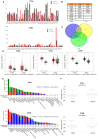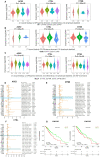Genomic, epigenomic, and immune subtype analysis of CTSL/B and SARS-CoV-2 receptor ACE2 in pan-cancer
- PMID: 33231569
- PMCID: PMC7746364
- DOI: 10.18632/aging.104147
Genomic, epigenomic, and immune subtype analysis of CTSL/B and SARS-CoV-2 receptor ACE2 in pan-cancer
Abstract
SARS-coronavirus 2 (SARS-CoV-2) has been spreading widely and posing an international challenge for both healthcare and society. At present, cancer has been identified as an individual risk factor for COVID-19. Angiotensin converting enzyme 2 (ACE2) and Cathepsin L/Cathepsin B (CTSL/B), which act as the receptor and entry-associated proteases of SARS-CoV-2 respectively, are pivotal for SARS-CoV-2 infection. To investigate the possible SARS-CoV-2 infection risk of pan-cancer, we analyzed the genetic alterations, RNA expression, DNA methylation, and the association with immune subtypes of ACE2 and CTSL/B with the prognosis in pan-cancer. Results showed the upregulation of CTSL/B and ACE2 in Pancreatic adenocarcinoma (PAAD) and Stomach adenocarcinoma (STAD) and demonstrated a positive correlation between copy number alteration (CNA) and gene expression for CTSB in PAAD and STAD. Hypomethylation and a negative correlation of gene expression and methylation for CTSB were detected in PAAD. In addition, ACE2 and CTSL/B are overexpressed in the IFN-gamma immune subtype of ovarian serous Cystadenocarcinoma (OV), Cervical squamous cell carcinoma and endocervical adenocarcinoma (CESC), and Bladder urothelial carcinoma (BLCA). Our study presents a bioinformatics assessment for the potential risk of SARS-CoV-2 infection in pan-cancer.
Keywords: COVID-19; CTSL/B; SARS-CoV-2.
Conflict of interest statement
Figures


Similar articles
-
Mediators of SARS-CoV-2 entry are preferentially enriched in cardiomyocytes.Hereditas. 2021 Jan 4;158(1):4. doi: 10.1186/s41065-020-00168-4. Hereditas. 2021. PMID: 33397514 Free PMC article.
-
Pan‑cancer analysis of transmembrane protease serine 2 and cathepsin L that mediate cellular SARS‑CoV‑2 infection leading to COVID-19.Int J Oncol. 2020 Aug;57(2):533-539. doi: 10.3892/ijo.2020.5071. Epub 2020 May 26. Int J Oncol. 2020. PMID: 32468052 Free PMC article.
-
Expression of SARS-CoV-2 Host Cell Entry Factors in Immune System Components of Healthy Individuals and Its Relevance for COVID-19 Immunopathology.Viral Immunol. 2021 Jun;34(5):352-357. doi: 10.1089/vim.2020.0277. Epub 2021 Jan 21. Viral Immunol. 2021. PMID: 33481684
-
Coronavirus disease 2019 and asthma, allergic rhinitis: molecular mechanisms and host-environmental interactions.Curr Opin Allergy Clin Immunol. 2021 Feb 1;21(1):1-7. doi: 10.1097/ACI.0000000000000699. Curr Opin Allergy Clin Immunol. 2021. PMID: 33186186 Review.
-
SARS-CoV-2 multifaceted interaction with the human host. Part II: Innate immunity response, immunopathology, and epigenetics.IUBMB Life. 2020 Nov;72(11):2331-2354. doi: 10.1002/iub.2379. Epub 2020 Sep 16. IUBMB Life. 2020. PMID: 32936531 Review.
Cited by
-
The accessible promoter-mediated supplementary effect of host factors provides new insight into the tropism of SARS-CoV-2.Mol Ther Nucleic Acids. 2022 Jun 14;28:249-258. doi: 10.1016/j.omtn.2022.03.010. Epub 2022 Mar 16. Mol Ther Nucleic Acids. 2022. PMID: 35313658 Free PMC article.
-
Cathepsins and their role in gynecological cancers: Evidence from two-sample Mendelian randomization analysis.Medicine (Baltimore). 2025 Mar 7;104(10):e41653. doi: 10.1097/MD.0000000000041653. Medicine (Baltimore). 2025. PMID: 40068078 Free PMC article.
-
Peripheral Blood Mononuclear Cell Biomarkers for Major Depressive Disorder: A Transcriptomic Approach.Depress Anxiety. 2024 Oct 3;2024:1089236. doi: 10.1155/2024/1089236. eCollection 2024. Depress Anxiety. 2024. PMID: 40226717 Free PMC article.
-
Angiotensin‑converting enzyme 2 expression in human tumors: Implications for prognosis and therapy (Review).Oncol Rep. 2025 Sep;54(3):101. doi: 10.3892/or.2025.8934. Epub 2025 Jun 27. Oncol Rep. 2025. PMID: 40576111 Free PMC article. Review.
-
Differentially expressed immune response genes in COVID-19 patients based on disease severity.Aging (Albany NY). 2021 Mar 29;13(7):9265-9276. doi: 10.18632/aging.202877. Epub 2021 Mar 29. Aging (Albany NY). 2021. PMID: 33780352 Free PMC article.
References
-
- Kuderer NM, Choueiri TK, Shah DP, Shyr Y, Rubinstein SM, Rivera DR, Shete S, Hsu CY, Desai A, de Lima Lopes G Jr, Grivas P, Painter CA, Peters S, et al., and COVID-19 and Cancer Consortium. Clinical impact of COVID-19 on patients with cancer (CCC19): a cohort study. Lancet. 2020; 395:1907–18. 10.1016/S0140-6736(20)31187-9 - DOI - PMC - PubMed
Publication types
MeSH terms
Substances
LinkOut - more resources
Full Text Sources
Medical
Miscellaneous

